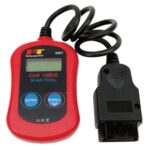Understanding the diagnostic systems in your vehicle is crucial for maintenance and repair, especially when dealing with classic sports cars like the Toyota MR2. A common question arises when owners of early MR2 models, specifically the 1992 MR2, inquire about OBDII compatibility. Let’s clarify the situation regarding the 1992 MR2 and OBDII, and delve into the evolution of on-board diagnostic systems in automobiles.
The question “does that only pertain to mr2’s? or all vehicles?” highlights a common misunderstanding about the scope of OBDII. The answer is definitively all vehicles sold in the US post-1996, not just the MR2. The implementation of OBDII was a mandated industry-wide change, impacting every automaker selling cars in the United States.
To understand why a 1992 MR2 isn’t OBDII compliant, it’s essential to look at the timeline of on-board diagnostics. In the early 1980s, as electronic engine management systems became increasingly complex, manufacturers started incorporating rudimentary on-board diagnostic (OBD) systems. These early OBD systems were manufacturer-specific and primarily designed to aid technicians in diagnosing issues. General Motors was among the pioneers, introducing OBD in some models during the 1980s. Other manufacturers followed suit, each developing their own proprietary systems.
However, these first-generation OBD systems lacked standardization. Recognizing the need for uniformity, and driven by environmental regulations, the Environmental Protection Agency (EPA) mandated a standardized system. This led to the development of the second-generation on-board diagnostic system, OBD-II. Crucially, OBD-II became mandatory for all cars and light trucks sold in the United States starting January 1, 1996.
Therefore, a 1992 Toyota MR2, being a pre-1996 vehicle, is not OBDII-equipped. It would have been equipped with an earlier, manufacturer-specific OBD system, often simply referred to as “OBD-equipped.” This distinction is important because OBD and OBDII are fundamentally different in their protocols, diagnostic capabilities, and connector types.
The OBD-II system brought about significant advancements. Modern vehicles rely heavily on electronic controls, with sensors monitoring various engine parameters and actuators controlling components like fuel injectors. An on-board computer, known as a Powertrain Control Module (PCM) or Engine Control Module (ECM), manages these systems. OBD-II systems are designed to monitor these sensors and actuators for malfunctions or deteriorations, often detecting problems before they become noticeable to the driver. This comprehensive monitoring system, encompassing sensors, actuators, and the diagnostic software within the PCM/ECM, constitutes the OBD system.
It’s also worth noting the point about oxygen (O2) sensors in MR2s. The number of O2 sensors in different MR2 models (49-state vs. California spec 3SGTE, and all 5SFE models having 2 sensors) is related to emission control requirements, not to the OBD or OBDII designation itself. Whether an MR2 has one or two O2 sensors is independent of whether it is OBD or OBDII compliant. All MKII MR2s were “OBD-equipped” in the general sense of having on-board diagnostics, but pre-date the OBDII standardization.
In conclusion, the “OBD” designation on a 1992 MR2, or any pre-1996 vehicle, refers to the earlier generation of manufacturer-specific on-board diagnostics, not the standardized OBDII system. For 1992 MR2 owners, understanding this distinction is key for proper diagnostics and maintenance. While your 1992 MR2 won’t have an OBDII port, it does possess an earlier diagnostic system that can still be valuable for troubleshooting when used with the appropriate tools and knowledge.
Reference:

